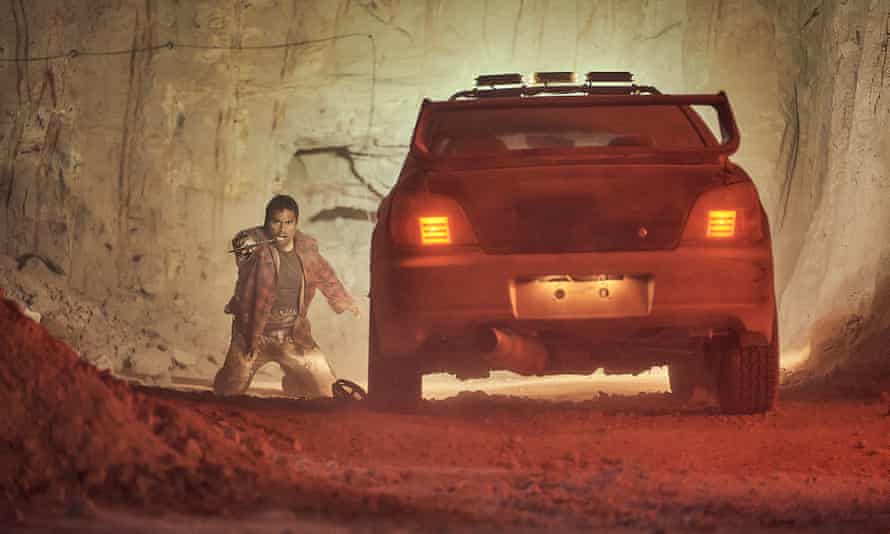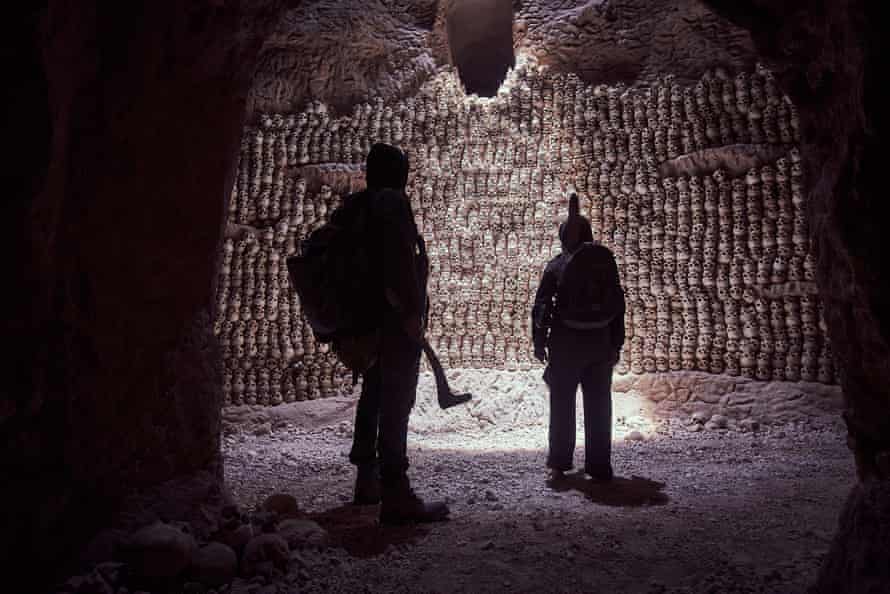Shared from Culture | The Guardian
In January 1788, a fleet of British ships under the command of Captain Arthur Phillip anchored in a bay known as Warrane to the people living there. What happened next is the familiar story of Australia’s founding. Less widely known is that 11 blood-sucking vampires were also brought ashore by the “First Fleet” that day. Once loose, they became addicted to the blood of Indigenous Australians and set about massacring the population, thereby weakening their resistance to the British invaders.
Or at least, that’s according to Shanika and Tyson, the vampire-killing “bloodhunters” at the centre of a new eight-part Australian series, Firebite. And who are we to argue?
Nothing less than history, and who gets to decide it, is at stake in the new wave of colonial-confronting horror being made by First Nations film-makers from all over the world. Firebite originated in the brain of Warwick Thornton, a Kaytetye man from Australia’s Northern Territory and an internationally feted film-maker since 2009, when his debut feature, Samson and Delilah, won the Caméra d’Or (best first feature prize) at Cannes.
Sign up to our Inside Saturday newsletter for an exclusive behind the scenes look at the making of the magazine’s biggest features, as well as a curated list of our weekly highlights
“Y’know, we’ve made a lot of really worthy films,” says Thornton wryly, referring to himself and his Firebite co-creator, Brendan Fletcher. Fletcher is a white Australian film-maker who has long worked with Indigenous communities in the Kimberley region of Western Australia, including on his 2011 Sundance hit, Mad Bastards. “But with this, we just wanted to kick in the doors and turn the amps up for our mob, so that our kids can see us killing vampires.”
Firebite absolutely lives up to that description, thanks to a raucous punk soundtrack and the rebellious energy of its two leads. Rob Collins, a well-established heart-throb with roots in the Tiwi Islands, plays Tyson, and relative newcomer Shantae Barnes-Cowan (an Adnyamathanha woman from South Australia) plays his adoptive daughter, Shanika. One of the white supporting characters is played by Australian actor Yael Stone, best known as Morello from Orange Is the New Black, who says she’s glad to be involved in a show that is correcting the “fantastical, polite version” of history she was taught at school. “Even if someone says: ‘That’s all bullshit,’ maybe they’ll then do some of their own research and find out: ‘Oh, actually, turns out there’s all these local massacre sites here, where I live,’” Stone says. “Because it really doesn’t take much to scratch the surface in Australia.”
Like Stone and many other Australians, Thornton was well into adulthood before he learned details about the brutality of the British colonists. One lodged firmly in his imagination: the existence of 11 vials of smallpox on the First Fleet, which many historians now believe amounts to an act of biological warfare against the original inhabitants. “A lot of the history books don’t write anything about vials of smallpox, or Indigenous people,” says Thornton. “They called the place terra nullius, which is a land of no people – but we were here. So every time we make a film, even if we’re just trying to have some rock’n’roll fun, it’s always going to be a bit deeper, darker and slightly shocking.”
The vampires-as-smallpox metaphor might be an elaboration on the historical record, but it would allow Thornton and Fletcher to get at the true horror of the past: “If you really wanted to talk about the Gadigal [the Indigenous population the colonisers first encountered] being wiped out by smallpox, it would be almost unwatchable,” he says. “So a vampire story is just a great device that allows us to, ironically, tell the truth, in terms of its essence.”
Firebite is one of several films and TV series in recent years to use popular genres to add clarity, unheard perspectives and, not least, lots of gore to the official, sanitised version of colonial history. Reservation Dogs, an Oklahoma-set, Indigenous show on Disney+, has won a slew of awards for its Seminole creator Sterlin Harjo, by melding native spiritual traditions – such as “Deer Lady” or a bad-omen owl – with irreverent comedy. That show’s star, Devery Jacobs, also appears in Blood Quantum (2019), an Indigenous – and ingenious – Canadian zombie movie from Mi’kmaq writer-director Jeff Barnaby, in which the Red Crow reservation becomes a sanctuary from the infected hordes of white-people zombies. Back in Australia, Bjorn Stewart, a Kuku-Yalanji/Wemba Wemba man, is developing his short Killer Native into another zombie feature, about a modern-day British couple terrorised by the reanimated corpses of the smallpox-ravaged dead.
While all these examples are recent, the Barbican in London is screening Tracey Moffatt’s 1993 film Bedevil, as part of their season Homeland: Films by Australian First Nations directors. This trio of ghost stories made Moffatt the first Australian Indigenous woman to direct a feature. Nearly 30 years later another Indigenous woman, Leah Purcell, has also chosen to make her feature debut in the genre space. The Drover’s Wife: The Legend of Molly Johnson, another film in the Homeland programme, is an outback western that reimagines Henry Lawson’s 1892 short story as a tale of resistance and resilience. Purcell herself stars as the eponymous, rifle-toting drover’s wife, alongside Firebite’s Rob Collins as a fugitive Indigenous man, loosely based on Purcell’s own great-grandfather.
“If you pick a popular genre, then you know you’re going to get an audience,” says Purcell of her decision to tell her story as a western. This sounds like a bait-and-switch move, but all genre thrills will be delivered as advertised: “First and foremost, I want to go out there and entertain people. Secondly, I will always, as an Indigenous woman, put [across] my family’s plight through those stories.”
For Indigenous film-makers, horror can be a means to reclaim stolen creative territory and otherwise get your own back. “In every Indigenous community, so much of our traditional storytelling is based in this sort of world,” says Thornton. “Not vampires, but in monsters and demons and morals.” Vampires, specifically, have no Australian roots and are best thought of as “just another kind of nasty animal that was sent here”, as much an invasive species as the European rabbit. Perhaps that’s why the traditional vampire-killing kit of holy water and a crucifix is useless here. Firebite’s fanged undead can only be slain by exposure to the scorching desert sun or a boomerang to the heart.

Vampire stories are endlessly adaptable and enduringly popular, but maybe, says Collins, it’s the changing perspectives that really matter. “I think Australia’s been swept up in what feels like a global urge to see diversity on screen. And there’s this feeling – I don’t know how accurate this is – that Indigenous stories are becoming really attractive to people abroad.”
Someone who agrees, and has the sales charts to prove it, is Emile Sherman, Firebite’s executive producer and the co-founder of UK-Australian production company See-Saw Films. See-Saw has never previously worked with an Indigenous director or an Indigenous-led cast, though it’s had huge successes with prestigious, socially minded dramas such as The King’s Speech (2011) and Lion (2016), both of which won numerous awards. But “now is the moment”, says Sherman, thanks to “a combination of interest in uncovering voices that haven’t been heard before, together with a genre-engine, together with the economic model of the S-Vods [streaming and video-on-demand] services”.
Previously, low-budget Indigenous horror such as Blood Quantum or Rodrick Pocowatchit’s zombie comedy The Dead Can’t Dance (2010) would only have been seen by small festival audiences. Now they are available to appreciative genre fans globally on Shudder and Amazon Prime Video, respectively. Meanwhile, deals such as the one See-Saw did with AMC+, the new streaming wing of the American network behind Breaking Bad, secured Firebite a budget that can really – as Thornton would put it – “kick in the doors and turn the amps up”.
So while it’s probably still true that history is written by the victors, media technology is helping to shift the narrative power balance. In Captain Arthur Phillip’s day it would have taken at least a year for any message about successfully subdued “natives” to get back to Britain. Now, thanks to the universal language of zombie gore, Indigenous people can get their side across at the speed of superfast broadband.
Firebite is coming soon to UK television. The Barbican’s Homeland: Films by Australian First Nations directors runs to 23 February. The Drover’s Wife: The Legend of Molly Johnson is out in cinemas nationwide on 13 May.
Images and Article from Culture | The Guardian

